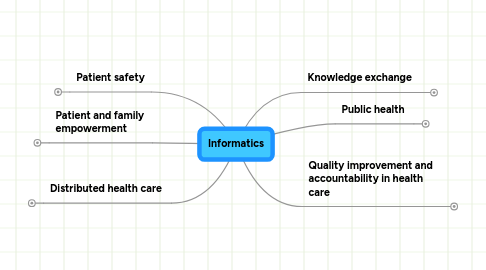Informatics
by Katrina Hurley


1. Patient safety
1.1. Patient alerts (e.g. flagged results)
1.2. Embedded decision support (e.g. drug alerts)
2. Patient and family empowerment
2.1. Patient education
2.1.1. Consumer health literacy
2.1.2. Patient centered decision support
2.2. Personal health record
2.2.1. Patient centered control of patient data
2.3. Impact of technology on patient-doctor relationship
3. Distributed health care
3.1. Telehealth
3.2. eHealth
3.3. Digital imaging
3.4. Clinical case conferences
4. Knowledge exchange
4.1. Medical records
4.1.1. Terminology standards
4.1.2. Coding
4.1.3. Data quality/accuracy
4.1.4. Architecture
4.2. Clinical information systems
4.3. Digital imaging repositories
4.4. Clinical decision support
4.4.1. Formulating answerable questions
4.4.2. Searching biomedical literature
4.4.3. Critical appraisal
4.5. Communities of practice
4.6. Enhanced simulations and medical games
5. Quality improvement and accountability in health care
5.1. Monitoring adherence to practice guidelines and pathways
5.2. Practice audit
5.3. Resource allocation
5.4. System performance (process and outcomes)
5.4.1. Measure results, changes in health associated with care-comfort, function, life span.
